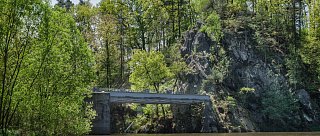Rechle - Unique technical monument
The most important technical monument listed on the Czech Republic's list of cultural monuments is the timber floatation dam, the so-called rechle in Plav.
In the years 1895 - 1896 an iron footbridge was built on high stone pillars on the river Malše and an iron gate called "rechle" was added to the footbridge. These are gates used to catch floating timber during navigation. The timber was floated from the Buquoy forests near Nové Hrady to České Budějovice.
To transport the timber from the Buquoy forests Nové Hrady waterways were built. By order of Count František Leopold Buquoy in 1778, engineer J. F. Riemer began to improve and regulate the watercourses, build weirs, culverts, etc. The aim was to get the wood to the Vltava, where it was bound into large vessels and floated to Prague. By sailing narrow rafts on the Malše, rafts were broken or short timber was floated. In order to contain the floating timber in front of the warehouse at Červený Dvůr in České Budějovice, a delay was built at Plav. A simple construction of chains and wooden piles to catch the wood was always built in the spring before each swim. A better device - rechle - was built in 1895-1896. The tank could gradually release the captured driftwood to the warehouse at Červený Dvůr, where it was fished out and further sorted according to type and quality, or narrow rafts were tied into larger ones for navigation on the Vltava.
The project, drawn up by the provincial engineer Johann Jirsík, was approved by the Prague governor on 11 July 1895. Construction began the same year and was financed by the estate of Nové Hrady Carl Buquoy. The construction was carried out by engineer Augustin Procházka for 30,000 gold coins.
During the floods in 2002 the water reached up to the level of the bridge.
An iron footbridge on two pillars was built behind the bend of the Malše River. The right-bank pillar consisted of partially dressed rock, while the middle and left-bank pillars were made of row masonry, which consisted of regular blocks with a paved surface. Under the footbridge there were two flow holes with a clearance of 18.2 m. The left hole had a wooden tusk made of combs. The right one had a movable iron comb consisting of four parts. The individual parts were lowered by chains using hand gates. The movable combs regulated the supply of floating timber to the store. The gates with conical drums and toothed gears were operated by cranks, so that individual parts could be lowered individually or all at once as required. The load-bearing part consisted of an iron gangway made of two riveted diagonally stiffened iron beams. The beams are I-shaped and 650 mm high.
Accessibility
year-round
How to get there
By car, by bike, on foot
Time needed to visit
2 Hours


